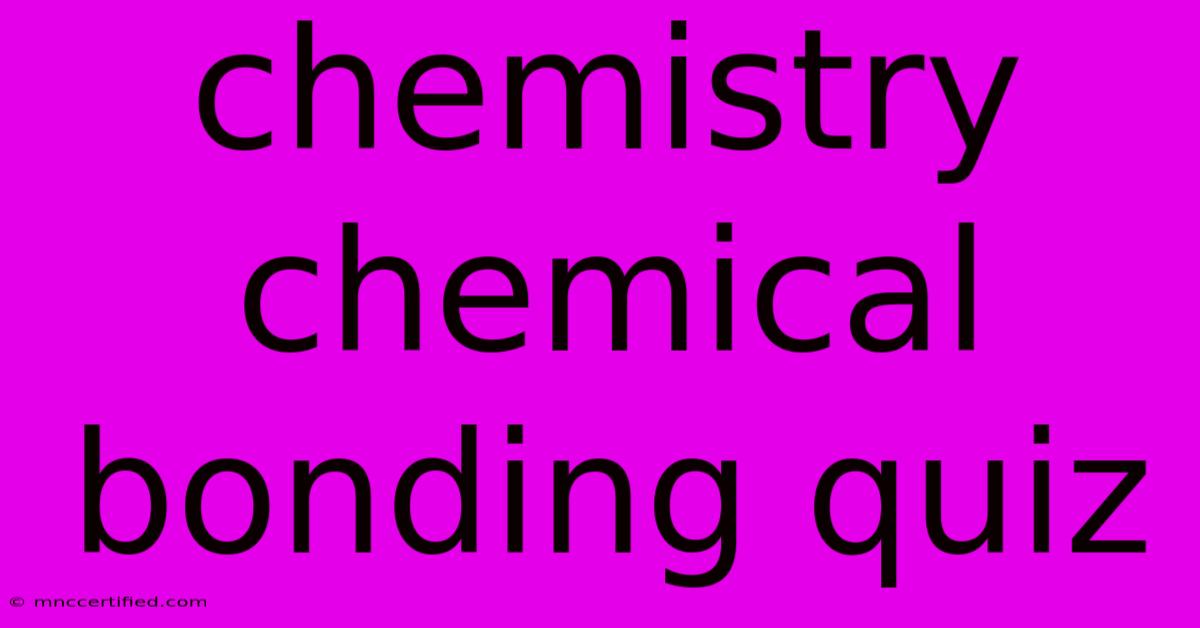Chemistry Chemical Bonding Quiz

Table of Contents
Chemistry Chemical Bonding Quiz: Test Your Knowledge!
Are you ready to put your understanding of chemical bonding to the test? This comprehensive quiz covers key concepts, from ionic and covalent bonds to metallic bonding and intermolecular forces. Whether you're a high school student prepping for an exam or a college student brushing up on your knowledge, this quiz will challenge and reinforce your learning. Let's dive in!
Understanding Chemical Bonding: A Quick Recap
Before we start the quiz, let's briefly review the fundamental types of chemical bonds:
1. Ionic Bonds: The Electrostatic Attraction
Ionic bonds form when electrons are transferred from one atom to another. This transfer creates ions: positively charged cations (atoms that have lost electrons) and negatively charged anions (atoms that have gained electrons). The electrostatic attraction between these oppositely charged ions forms the ionic bond. Think of table salt (NaCl) – a classic example of an ionic compound.
2. Covalent Bonds: Sharing is Caring
Covalent bonds involve the sharing of electrons between atoms. This sharing allows atoms to achieve a stable electron configuration, often fulfilling the octet rule (eight electrons in the valence shell). Covalent bonds are prevalent in organic molecules and many other compounds. Water (H₂O) is a prime example of a molecule with covalent bonds.
3. Metallic Bonds: A Sea of Electrons
Metallic bonds occur in metals. In this type of bonding, valence electrons are delocalized, forming a "sea" of electrons that surrounds the positively charged metal ions. This "sea" of electrons accounts for the characteristic properties of metals, such as conductivity and malleability.
4. Intermolecular Forces: Attractions Between Molecules
Intermolecular forces are weaker attractions between molecules. These forces are crucial in determining the physical properties of substances, such as boiling point and melting point. Examples include hydrogen bonding, dipole-dipole interactions, and London dispersion forces.
Chemistry Chemical Bonding Quiz: Let's Begin!
Now, let's test your knowledge! Answer the following multiple-choice questions to the best of your ability.
1. Which type of bond involves the transfer of electrons? a) Covalent bond b) Metallic bond c) Ionic bond d) Hydrogen bond
2. What is the octet rule? a) Atoms tend to gain or lose electrons to achieve a full outer shell of 10 electrons. b) Atoms tend to gain or lose electrons to achieve a full outer shell of 8 electrons. c) Atoms always share electrons equally in a covalent bond. d) Atoms always transfer electrons equally in an ionic bond.
3. Which of the following is NOT a characteristic property of metals? a) Malleability b) Ductility c) Brittleness d) Conductivity
4. Which type of intermolecular force is the strongest? a) London Dispersion Forces b) Dipole-Dipole Interactions c) Hydrogen Bonding d) Ion-Dipole Interactions
5. Which of the following compounds is likely to exhibit predominantly covalent bonding? a) NaCl b) MgO c) CH₄ d) KCl
6. What type of bond is found in diamond? a) Ionic b) Metallic c) Covalent d) Hydrogen
Answer Key & Explanations
1. c) Ionic bond - Ionic bonds are formed by the transfer of electrons, creating ions with opposite charges that attract each other.
2. b) Atoms tend to gain or lose electrons to achieve a full outer shell of 8 electrons. - The octet rule is a guideline for predicting the stability of atoms based on their electron configuration.
3. c) Brittleness - Brittleness is a characteristic of ionic compounds, not metals. Metals are typically malleable and ductile.
4. c) Hydrogen Bonding - Hydrogen bonding is a particularly strong type of dipole-dipole interaction.
5. c) CH₄ - Methane (CH₄) is a molecule with covalent bonds between carbon and hydrogen atoms.
6. c) Covalent - Diamond is a giant covalent structure consisting of carbon atoms bonded covalently.
Improve Your Understanding Further
This quiz is just a starting point. To further solidify your understanding of chemical bonding, consider exploring these resources:
- Textbooks: Consult your chemistry textbook for more in-depth explanations and examples.
- Online Resources: Websites like Khan Academy and Chemguide offer excellent tutorials and interactive exercises.
- Practice Problems: Work through additional practice problems to reinforce your learning.
This quiz and the accompanying information provide a solid foundation in chemical bonding. Remember that consistent practice and exploration are key to mastering this crucial chemistry concept. Good luck with your studies!

Thank you for visiting our website wich cover about Chemistry Chemical Bonding Quiz. We hope the information provided has been useful to you. Feel free to contact us if you have any questions or need further assistance. See you next time and dont miss to bookmark.
Featured Posts
-
Disadvantages Of Dental Bonding
Nov 22, 2024
-
Supreme Court Reverses Smolletts Conviction
Nov 22, 2024
-
Strictlys Jowita Swaps Partners
Nov 22, 2024
-
Another Eruption Icelands Reykjanes Volcano
Nov 22, 2024
-
Duluth Trading Mens Sweatshirts
Nov 22, 2024